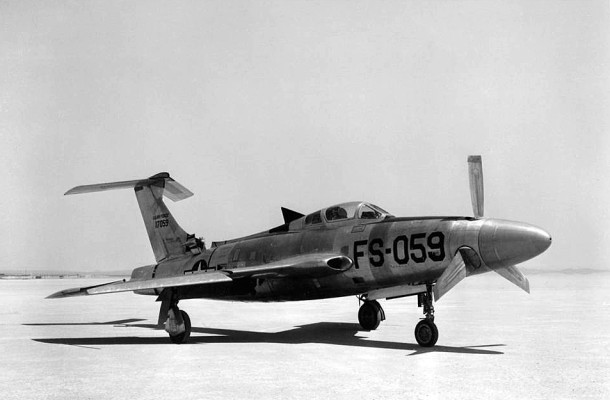
Sixty-four years ago this month, the USAF/Republic XF-84H experimental turboprop fighter took to the air on its maiden flight. The test sortie was flown at Edwards Air Force Base with Republic test pilot Henry G. “Hank” Beaird, Jr. at the controls.
The XF-84H was an experimental variant of Republic Aviation’s turbojet-powered F-84 Thunderstreak. An Allison XT40-A-1 turboprop engine, rated at 5,850 hp, served as the power source for this novel aircraft. The XT40 drove a variable-pitch, 3-blade, 12-foot diameter propeller at 3,000 rpm. Thrust level was changed by varying blade pitch.
Owing to its high rotational speed and large diameter, the outer 2 feet of the XF-84H propeller saw supersonic velocities. The shock waves that emanated from the prop produced a deafening wall of sound. The extreme sound level produced intense nausea and raging headaches in ground crewmen. As a result, the XF-84H was dubbed the Thunderscreech.
The prop wash from the aircraft’s powerful turboprop necessitated the use of a T-tail to keep the horizontal tail and elevator in clean air flow. The engine’s extreme torque was partially countered by differential deflection on the left and right wing flaps and by placement of the aircraft’s left wing root air intake a foot ahead of the its right intake.
A pair of XF-84H prototype aircraft (S/N 51-17059 and S/N 51-17060) was built by Republic Aviation. The inaugural flight of an XF-84H took place on Friday, 22 July 1955 at Edwards Air Force. This test hop, performed in Ship No. 1 (S/N 51-17059), was cut short by a forced landing.
A total of twelve (12) test flights were made in the two Thunderscreech prototypes; eleven (11) in Ship No. 1 and one (1) in Ship No. 2. Total flight time accumulated by these experimental airframes was 6 hours and 40 minutes. The majority of flights experienced forced landings for one reason or another.
The XF-84H suffered from reduced longitudinal stability and poor handling qualities. The aircraft was also plagued by frequent engine, hydraulic system, nose gear and vibration problems. Faced with the type’s obvious non-viability, USAF opted to cancel the XF-84H Program in September of 1956.
Historical records indicate that the XF-84H reached a top speed of 520 mph during its brief flight test life. This figure was a full 120 mph short of the aircraft’s design speed. Nonetheless, the XF-84H held the speed record for single-engine prop-driven aircraft until Monday, 21 August 1989. On that date, a specially modified Grumman F8F Bearcat established the existing record of 528.33 mph.
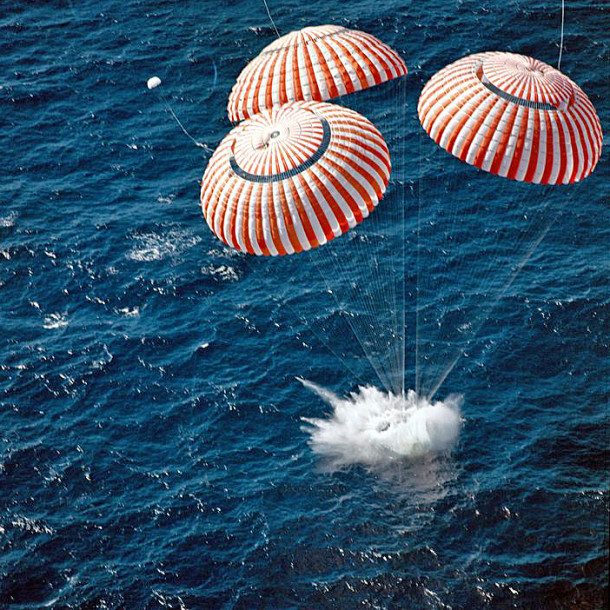
Fifty years ago today, Apollo 11 astronauts Neil Alden Armstrong, Edwin Eugene Aldrin, Jr., and Michael Collins returned safely to the Earth to bring to a close the first space mission to land men on the lunar surface. With their safe return, President John F. Kennedy’s inspired national goal of landing men on the Moon and bringing them safely home before the end of the 1960’s was successfully accomplished.
The crew of Apollo 11 and their celestial chariot, Columbia, splashed-down in the Pacific Ocean at a point 812 nautical southwest of Hawaii. The epic journey to the Moon and back covered 952,700 nautical miles. Mission total elapsed time was 195 hours, 18 minutes, and 35 seconds.
Following splashdown, the Apollo 11 astronauts and their Command Module Columbia were brought aboard the USS Hornet (CV-12). Concerned that they would infect Earthlings with lunar pathogens, NASA quarantined the astronauts in the Mobile Quarantine Facility (MQF), which was a converted vacation trailer.
The Hornet steamed for Hawaii and transferred the MQF for airlift to Ellington Air Force Base, Texas. Following landing, the MQF and its heroic occupants were transported to the Johnson Spacecraft Center (MSC) in Houston, Texas. Once there, the astronauts and several medical staff were transferred from the MQF to more substantial accommodations known as the Lunar Receiving Laboratory (LRL).
Combined stay time in the MQF and LRL was 21 days. During their forced confinement, Armstrong, Aldrin, and Collins debriefed the Apollo 11 mission, rested, and mused about their unforgettable experiences at the Moon.
The Apollo 11 astronauts were released from the LRL on Thursday, 13 August 1969, having never contracted nor transmitted a lunar disease.
Parenthetically, Apollo 11 brought the first geologic samples from the Moon back to Earth. Roughly 48 pounds of lunar rock samples were collected. Two primary types of rocks, basalts and breccias, were found at the Sea of Tranquility landing site. Subsequent analyses indicated that these samples neither contained water nor provided evidence for living organisms at any time in the history of the Moon.
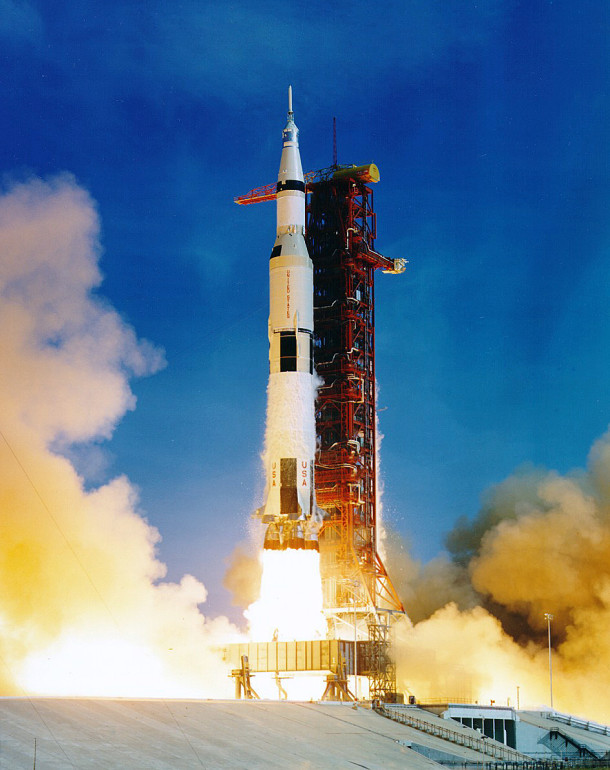
Fifty years ago today, the epic flight of Apollo 11, the first mission to land men on the Moon, began with launch from the Kennedy Space Center (KSC) at Merritt Island, Florida. Nearly 1-million people gathered around America’s famous space complex to witness the historic event. An estimated 1-billion viewers worldwide watched the proceedings on television.
The names of the Apollo 11 crew are now legend: Mission Commander Neil A. Armstrong, Lunar Module Pilot Edwin E. Aldrin, Jr., and Command Module Pilot Michael Collins. Each astronaut was making his second spaceflight.
The overall Apollo 11 spacecraft weighed over 100,000 pounds and consisted of 3 major components: Command Module, Service Module, and Lunar Excursion Module (LEM). Out of American history came the names used to distinguish two of these components from one another. The Command Module was named Columbia, the feminine personification of America, while the Lunar Excursion Module received the appellation Eagle in honor of America’s national bird.
The Apollo-Saturn V launch stack measured 363-feet in length, had a maximum diameter of 33-feet, and weighed 6.7-milllion pounds at ignition of its five F-1 engines. The vehicle rose from the Earth on 7.7-million pounds of lift-off thrust.
The acoustic energy produced by the Saturn’s first stage propulsion system was unlike anything in common experience. The sound produced was like intense, continuous thunder even miles away from the launch point. Ground and structure shook disturbingly and a person’s lungs vibrated within their chest cavity.
Lift-off of Apollo 11 (AS-506) from KSC’s LC-39A occurred at 13:32 UTC on Wednesday, 16 July 1969. The target for the day’s launch, the Moon, was 218,096 miles distant from Earth. It took 12 seconds just for the massive Apollo 11 launch vehicle to clear the launch tower. However, a scant 12 minutes later, the Apollo 11 spacecraft was safely in low earth orbit (LEO) traveling at 17,500 miles per hour.
Following checkout in earth orbit, trans-lunar injection, and earth-to-moon coast, Apollo 11 entered lunar orbit nearly 76 hours after lift-off. Now, the big question: Would they make it? Even Apollo 11’s Command Module Pilot, Michael Collins, estimated that the chance of a successful lunar landing on the first attempt was only 50/50. The answer would soon come. History’s first lunar landing attempt was now only 24 hours away.
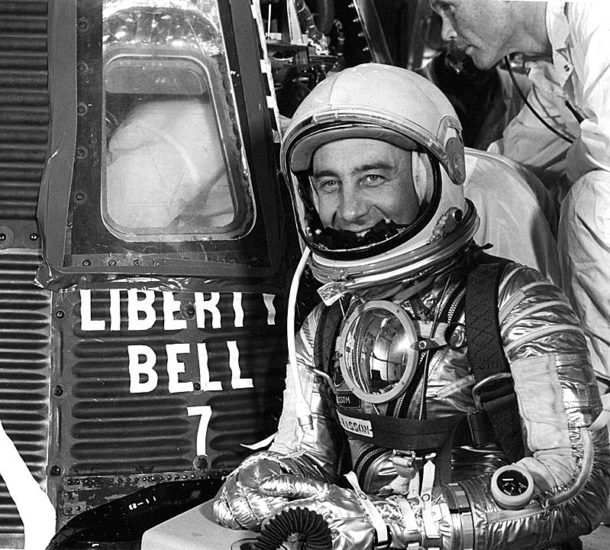
Fifty-eight years ago this month, Mercury Seven Astronaut Vigil I. “Gus” Grissom, Jr. became the second American to go into space. Grissom’s suborbital mission was flown aboard a Mercury space capsule that he named Liberty Bell 7.
The United States first manned space mission was flown on Friday, 05 May 1961. On that day, NASA Astronaut Alan B. Shepard, Jr. flew a 15-minute suborbital mission down the Eastern Test Range in his Freedom 7 Mercury spacecraft. Known as Mercury-Redstone 3, Shepard’s mission was entirely successful and served to ignite the American public’s interest in manned spaceflight.
Shepard was boosted into space via a single stage Redstone rocket. This vehicle was originally designed as an Intermediate-Range ballistic Missile (IRBM) by the United States Army. It was man-rated (that is, made safer and more reliable) by NASA for the Mercury suborbital mission. A descendant of the German V-2 missile, the Redstone produced 78,000 lbs of sea level thrust.
Shepard’s suborbital trajectory resulted in an apogee of 101 nautical miles (nm). With a burnout velocity of 7,541 ft/sec, Freedom 7 splashed-down in the Atlantic Ocean 263 nm downrange of its LC-5 launch site at Cape Canaveral, Florida. Shepard endured a maximum deceleration of 11 g’s during the reentry phase of the flight.
Mercury-Redstone 4 was intended as a second and confirming test of the Mercury spacecraft’s space-worthiness. If successful, this mission would clear the way for pursuit and achievement of the Mercury Program’s true goal which was Earth-orbital flight. All of this rested on the shoulders of Gus Grissom as he prepared to be blasted into space.
Grissom’s Liberty Bell 7 spacecraft was a better ship than Shepard’s steed from several standpoints. Liberty Bell 7 was configured with a large centerline window rather than the two small viewing ports featured on Freedom 7. The vehicle’s manual flight controls included a new rate stabilization system. Grissom’s spacecraft also incorporated a new explosive hatch that made for easier release of this key piece of hardware.
Mercury-Redstone 4 (MR-4) was launched from LC-5 at Cape Canaveral on Friday, 21 July 1961. Lift-off time was 12:20:36 UTC. From a trajectory standpoint, Grissom’s flight was virtually the same as Shepard’s. He found the manual 3-axis flight controls to be rather sluggish. Spacecraft control was much improved when the new rate stabilization system was switched-on. The time for retro-fire came quickly. Grissom invoked the retro-fire sequence and Liberty Bell 7 headed back to Earth.
Liberty Bell 7’s reentry into the Earth’s atmosphere was conducted in a successful manner. The drogue came out at 21,000 feet to stabilize the spacecraft. Main parachute deployed occurred at 12,300 feet. With a touchdown velocity of 28 ft/sec, Grissom’s spacecraft splashed-down in the Atlantic Ocean 15 minutes and 32 seconds after lift-off. America now had both a second spaceman and a second successful space mission under its belt.
Following splashdown, Grissom logged final switch settings in the spacecraft, stowed equipment and prepared for recovery as several Marine helicopters hovered nearby. As he did so, the craft’s new explosive hatch suddenly blew for no apparent reason. Water started to fill the cockpit and the surprised astronaut exited the spacecraft as quickly as possible.
Grissom found himself outside his spacecraft and in the water. He was horrified to see that Liberty Bell 7 was in imminent peril of sinking. The primary helicopter made a valiant effort to hoist the spacecraft out of the water, but the load was too much for it. Faced with losing his vehicle and crew, the pilot elected to release Liberty Bell 7 and abandon it to a watery grave.
Meanwhile, Grissom struggled just to stay afloat in the churning ocean. The prop blast from the recovery helicopters made the going even tougher. Finally, Grissom was able to retrieve and get himself into a recovery sling provided by one of the helicopters. He was hoisted aboard and subsequently delivered safely to the USS Randolph.
In the aftermath of Mercury-Redstone 4, accusations swirled around Grissom that he had either intentionally or accidentally hit the detonation plunger that activated the explosive hatch. Always the experts on everything, especially those things which they have little comprehension of, the denizens of the press insinuated that Grissom must have panicked. Grissom steadfastly asserted to the day that he passed from this earthly scene that he did no such thing.
Liberty Bell 7 rested at a depth of 15,000 feet below the surface of the Atlantic Ocean until it was recovered by a private enterprise on Tuesday, 20 July 1999; a day short of the 38th anniversary of Gus Grissom’s MR-4 flight. The beneficiary of a major restoration effort, Liberty Bell 7 is now on display at the Kansas Cosmosphere and Space Center. The spacecraft’s explosive hatch was never found.
As for Gus Grissom, ultimate vindication of his character and competence came in the form of his being named by NASA as Commander for the first flights of Gemini and Apollo. Indeed, Grissom and rookie astronaut John W. Young successfully made the first manned Gemini flight in March of 1965 during Gemini-Titan 3. Later, Grissom, Edward H. White II and Roger B. Chaffee trained as the crew of Apollo 1 which was slated to fly in early 1967. Their lives were tragically cut short as a result of the infamous AS-204 (Apollo 1) Spacecraft Fire of Friday, 27 January 1967.
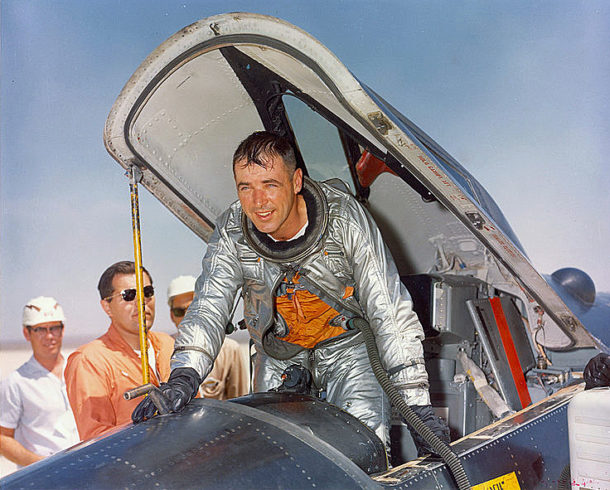
Fifty-seven years ago this month, USAF Major Robert M. White flew the North American X-15 hypersonic research aircraft to a record altitude of 314,750 feet (51.8 nautical miles). In doing so, he became the first X-15 pilot to be awarded USAF Astronaut Wings.
The North American X-15 was the first manned hypersonic aircraft. It was designed, engineered, constructed and first flown in the 1950′s. As originally conceived, the X-15 was designed to reach 4,000 mph (Mach 6) and 250,000 feet. Before its flight test career was over, the type would meet and exceed both performance goals.
North American built a trio of X-15 airframes; Ship No. 1 (S/N 56-6670), Ship No. 2 (56-6671) and Ship No. 3 (56-6672). The X-15 measured 50 feet in length, had a wing span of 22 feet and a GTOW of 33,000 lbs. Ship No. 2 would later be modified to the X-15A-2 enhanced performance configuration. The X-15A-2 had a length of 52.5 feet and a GTOW of around 56,000 lbs.
The Reaction Motors XLR-99 rocket engine powered the X-15. Small, but mighty, the XLR-99 generated 57,000 pounds of sea level thrust at full-throttle. It weighed only 910 pounds. The XLR-99 used anhydrous ammonia and LOX as propellants. Burn time varied between 83 seconds for the stock X-15 and about 150 seconds for the X-15A-2.
The X-15 was carried to drop conditions (typically Mach 0.8 at 42,000 feet) by a B-52 mothership. A pair of aircraft were used for this purpose; a B-52A (S/N 52-003) and a B-52B (S/N 52-008). Once dropped from the mothership, the X-15 pilot lit the XLR-99 to accelerate the aircraft. The X-15A-2 also carried a pair of drop tanks which provided propellants for a longer burn time than was possible with the stock X-15 flight.
The X-15 employed both aerodynamic and reaction flight controls. The latter were required to maintain vehicle attitude in space-equivalent flight. The X-15 pilot wore a full-pressure suit in consequence of the aircraft’s extreme altitude capability. The typical X-15 drop-to-landing flight duration was on the order of 10 minutes. All X-15 landings were performed dead-stick.
On Tuesday, 17 July 1962, Bob White flew his 15th X-15 mission. The X-15 and White had already become the first aircraft-pilot duo to hit Mach 4, 5 and 6. On this particular day, White was at the controls of X-15 Ship No. 3. It was the 62nd flight research mission of the X-15 Program with a target maximum altitude of 282,000 feet.
At 09:31:10 UTC, X-15 Ship No. 3 was launched from the B-52B mothership commanded by USAF Captain Jack Allavie. White lit the XLR-99 and pulled into a steep climb. His hypersonic steed rapidly gained altitude. Burnout of the XLR-99 occurred 82 seconds after ignition; 2.0 seconds longer than planned. At this point, White was traveling at 3,832 mph or Mach 5.45. Following an uneventful climb to apogee and a expertly-flown reentry, White touched-down safely on Rogers Dry Lake at 09:41:30 UTC. His reaction to the entire experience was succinctly expressed when he exclaimed, “Boy, that was a ride!”
The extra impulse provided by the longer-than-planned burn of the XLR-99 rocket engine drove White’s X-15 more than 32,000 feet higher than planned. The resulting apogee of 314,750 feet established a still-standing FAI world altitude record for piloted aircraft. The occasion also marked the first time that the X-15 flew higher than 300,000 feet. For flying beyond 50 statute miles (264,000 feet), Bob White received USAF Astronaut Wings; the first X-15 pilot to be awarded such.
Bob White piloted the X-15 a total of sixteen (16) times. He was one (1) of only twelve (12) men to fly the aircraft. White left X-15 Program and Edwards AFB in 1963. He went on to serve his country in numerous capacities as a member of the Air Force including flying 70 combat missions in Viet Nam. He returned to Edwards AFB as AFFTC Commander in August of 1970.
Major General Robert M. White retired from the United States Air Force in 1981. During his period of military service, he received numerous decorations and awards including the Air Force Cross, Distinguished Service Medal, Silver Star with three oak leaf clusters, Legion of Merit, Distinguished Flying Cross with four oak leaf clusters, Bronze Star Medal, and Air Medal with 16 oak leaf clusters.
Bob White was a true American hero. He was one of those heroes who neither sought nor received much notoreity for his accomplishments. He served his country and the aviation profession well. Bob White’s final flight occurred on Wednesday, 17 March 2010. He was 85 years of age.





